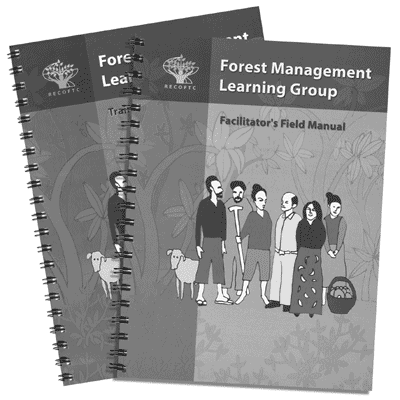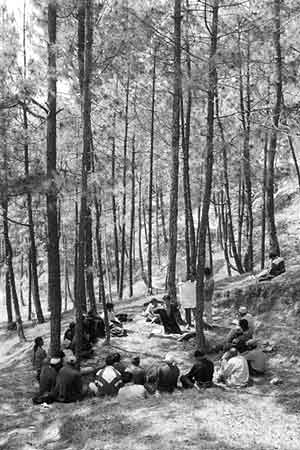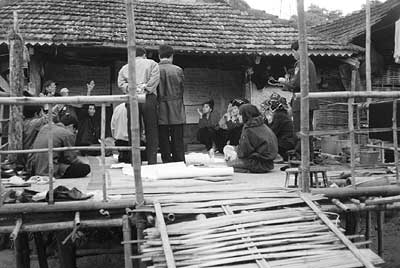


M. Miagostovich
Marco Miagostovich was the Forest Management Learning Group Coordinator, Regional Community Forestry Training Center for Asia and the Pacific (RECOFTC), Kasetsart University, Bangkok, Thailand until 2002. He is now working on ecosystem analysis with the Marine Resources Service, FAO Fisheries Department, Rome.
Surveys of forestry education institutions help prioritize regional forestry education needs.
The concept of the forest management learning group (FMLG), developed in Asia by the Regional Community Forestry Training Center (RECOFTC) together with partner institutions, projects and local people, is an innovative approach to the development of silvicultural practices within community-based forest resource management regimes. It is based on the Farmer Field School approach, developed by FAO for integrated pest management in rice production in the region.
The approach recognizes the right and the interest of local people to be involved in managing, conserving and where necessary rehabilitating the forest, and in developing new technologies through direct experimentation. It recognizes the capacity of forest users to seek innovative silvicultural solutions to address their needs for forest products.
The FMLG process was developed over about three years through workshops and pilot field activities. A facilitator's field manual was drafted based on these experiences, and a training curriculum and training material were developed to enable field officers to become facilitators. With increasing interest in the FMLG process, field-based training of trainers has been developed to build national training capacity.
The FMLG approach has been tested in Nepal and Viet Nam, and the training materials have also been requested for use in Indonesia and the Philippines.

Training materials developed for use in the forest management learning group process
The forest management learning group uses non-formal, participatory adult education methods that focus on local needs and build on the users' knowledge and experiences. It helps them develop the capacity to analyse their present practices and to develop and test possible solutions to their prioritized forest production problems - rather than targeting forest users with preset messages as in traditional extension. Identified silvicultural practices can then be incorporated into the community forest management plan.
The process is based on shared learning among users (local people who depend on the forest for their livelihoods and are members of a formal or informal forest management group) and facilitators. The facilitator's job is to encourage learning rather than to deliver information, offer explanations or provide answers. Facilitators initiate discussion, highlight, summarize, compare and connect remarks and point out opposing views. Facilitators guide the process, but not the outcome. The facilitator should also identify and mobilize other resource persons (such as forestry staff, knowledgeable farmers and specialists) qualified to address any issues that may arise outside his or her range of technical knowledge or skills.
The learning group usually consists of 20 to 25 participants selected from and by the members of the community. Ideally the FMLG members should represent all the different forest interest groups (stakeholders) in the community. In practice, unfortunately, there is often a tendency to include more powerful or prominent members of the community and to exclude minority groups.
The process lasts at least one to two years, depending on the silvicultural practices under experimentation. Initially the FMLG will meet at least four or five times to undertake the initial assessments before the season when forestry operations begin. During the season, the frequency of meetings may vary from once a month to once every three to six months, depending on the experiment. In general there are about five to seven meetings in the first season. It is suggested that group meetings take no more than half a day (three to four hours).
The following are the main steps in the process:
selection of the site and community, based on the expressed interest of the community and a commitment for the full period needed to test the forest management practices (at least one year);
selection of the learning group members by the community;
clarification of the concerns, roles and responsibilities of the FMLG members, and establishment of group norms;
identification of the role of the forest in present livelihood systems and the anticipated forest production needs of the community, and selection of the forest area where experimental plots will be established;
pooling of ideas about management practices and silvicultural techniques that might address the identified forest production needs, for evaluation through field experimentation;
planning and establishment of field experiments;
regular observation of selected indicators to monitor the forest management practices under experimentation and to introduce any corrective measures that might be necessary;
regular group meetings (two to three half-days during the season) to reflect on the field observations;
sharing of results and lessons learned with the whole community at different times during the season, so possible changes to the existing forest management plan can be made;
self-evaluation at the end of the season, followed by replanning (deciding whether to continue with the present experimentation or to explore new issues).

A forest management learning group in Nepal pools ideas
about which
management practices to test to address the users' forest production needs
Two leasehold groups within the Nepal-FAO Hills Leasehold Forestry and Forage Development Project initiated a farmers' forest management school, an FMLG process, in mid-2000. Under the FAO-Nepal project, blocks of degraded forest are leased to poor households for 25 to 50 years with the aim of reducing poverty and environmental degradation. The two leasehold groups in Makwanpur district which started the FMLG have seven and five members, respectively. Each member has about 1 ha of land with a 25-year lease and an operational plan.
The group had already successfully established the production of fodder grasses - used to feed livestock and to produce seeds for market - on their forest land. The group did not have previous experience in forest management and their knowledge of forest management practices was limited.
The FMLG identified income generation from fuelwood production (mainly for the market but also for their own consumption) as the need to be addressed. The learning group drew up a list of about 25 familiar fuelwood species and found that seven of these species were available in their own forest. They ranked the seven species according to perceived fuelwood and coppicing potential (quantity and quality) and identified four species worthy of experimentation. The aim was to identify the fastest-growing species which would produce the largest amount of fuelwood in the shortest time, the species with the strongest coppicing capacity, and the most effective spacing between trees.
The FMLG established five experimental plots plus one control, which would be observed for at least two years. Farmers regularly observed changes taking place in the experimental plots, mainly through visual observation and the use of local measurements. The use of measuring tape for record-keeping was more difficult, owing to the high illiteracy level of the group. The following measurements were recorded:
diameter and height of each tree left standing (by hand size and measuring tape);
number, size and length (by finger, arm) of new sprouts/coppice at six months;
amount / weight of biomass produced by coppicing at six months (by backload);
fuelwood harvested (by backload).

Members of the forest management learning group in
Makwanpur district,
Nepal, demarcate an experimental plot in the forest

Villagers in Na Nga, Viet Nam, assess their needs with regard to the local bamboo forest
Na Nga is a Thai ethnic minority village in Yen Chau district of Son La Province in northern Viet Nam. The FMLG process in Na Nga was developed in collaboration with the Social Forestry Development Programme, a technical cooperation programme between the Viet Nam Government and the German Agency for Technical Cooperation (GTZ), which was already assisting the district. Na Nga has 115 households and a total population of 527 people. Its 575 ha include 124 ha of natural forest and 64 ha of forest plantations. The villagers' livelihoods are mainly based on the production of maize, cassava, mangoes and fish.
Land-use planning and land allocation were carried out in 1998. Since 1999, 112 land right certificates have been issued to households. Community forestry development activities carried out so far have included the preparation of village-level forest protection and development regulations and a plan to protect the community forest.
During the FMLG process the Na Nga villagers decided that their priority area for study was techniques for bamboo pole production and associated protection needs. The farmers recognized that the bamboo forest was not managed well; it was too dense and was cut haphazardly. They agreed to experiment with the following silvicultural practices:
avoiding cutting the first shoot of the season, because it would inhibit the growth, number and strength of other shoots;
cutting the old bamboo poles (perhaps leaving one or two to help the new shoot grow straight);
removing any bamboo growing bent or showing evidence of disease;
pruning poles up to 1 m from the ground;
cutting old bamboo at 50 cm from the ground;
banning the collection of bamboo shoots from the plot.
They selected an area of about 1 000 m2 for the experimental plots, which they demarcated using a rope representing a common local land measurement unit. They agreed to place nearby a clearly visible signboard indicating the experimental techniques to discourage community members from cutting the bamboo in the experimental plots.
Six main indicators were selected for regular observations: number of bamboo shoots; number of poles; soil moisture (by observation, i.e. by removing leaf litter and then physically inspecting the soil); shape of poles (straight or bent); size of poles (by string measurement); and length of poles (by string measurement).
|
Feedback from farmers involved in forest management learning group trials We thought [the facilitator] would come and tell us what to cut and how, but afterwards we learned that we can find out by ourselves by answering [the facilitator's] questions. At the beginning it was a very confusing process but after three or four days, when we prioritized our own needs, it became clearer and we found out that maybe we could meet our own needs through different management practices. We thought [the facilitator was] going to talk about forest management at first, but we talked about everything except forest management! After a struggle we have come to an understanding about the benefits of this way of learning. We thought that managing the forest meant to protect it, to leave it to grow in its natural condition, not to touch, cut or harvest it. After the establishment of the experimental plots we have discovered that we can manage the forest not only by leaving it alone but also by cutting it. We have many ideas that we would like to try. |
The forest management learning group approach may provide a means:
to identify ways of meeting local users' needs better and to improve existing management plans accordingly;
to improve the capacity, knowledge and confidence of local forest managers and of facilitators working with them;
to generate and spread locally appropriate information.
The approach is most appropriate for communities where a community forest management plan is already being implemented, appropriate responsible village institutions are in place and functioning, and the community has the recognized authority (formal or informal) to carry out experiments and forestry operations on the pertinent forest land.
The costs of employing a facilitator for six half-day meetings of the group during the first year and two or three during the following two years might seem high given the small number of participants. However, the small group that attends the FMLG meetings represents the community at large - which could be more than 1 000 households over a forest area larger than 500 ha. The small group is empowered through the FMLG process to reach the larger community - to keep the community informed and share the findings.
After the steps of assessing learning needs, negotiating with the community stakeholders on what should be tested and setting up the experimentation, the need for the facilitator gradually decreases through the process. Indeed, one of the aims of the facilitator is to help the groups become independent so that they will continue the process in the years to come. Thus the objective of the FMLG is not only to carry out pure research (which is not necessarily the most efficient way for communities to acquire silvicultural knowledge), but also to help build users' confidence in their ability to address their clearly identified needs and to look for answers to new questions. Ideally, once users have developed sufficient confidence, different user groups will be able to exchange knowledge so that not every group will start from zero.
Implementing the forest management learning group process will require a shift in forestry planning and extension strategies. Forestry personnel will require a new set of skills to support their shifting role from technician to facilitator - skills for mobilizing community knowledge and practice, opening up channels of communication and building mutual understanding among users in participatory decision-making processes.